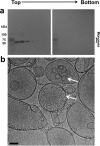Disentangling the roles of cholesterol and CD59 in intermedilysin pore formation
- PMID: 27910935
- PMCID: PMC5133593
- DOI: 10.1038/srep38446
Disentangling the roles of cholesterol and CD59 in intermedilysin pore formation
Abstract
The plasma membrane provides an essential barrier, shielding a cell from the pressures of its external environment. Pore-forming proteins, deployed by both hosts and pathogens alike, breach this barrier to lyse target cells. Intermedilysin is a cholesterol-dependent cytolysin that requires the human immune receptor CD59, in addition to cholesterol, to form giant β-barrel pores in host membranes. Here we integrate biochemical assays with electron microscopy and atomic force microscopy to distinguish the roles of these two receptors in mediating structural transitions of pore formation. CD59 is required for the specific coordination of intermedilysin (ILY) monomers and for triggering collapse of an oligomeric prepore. Movement of Domain 2 with respect to Domain 3 of ILY is essential for forming a late prepore intermediate that releases CD59, while the role of cholesterol may be limited to insertion of the transmembrane segments. Together these data define a structural timeline for ILY pore formation and suggest a mechanism that is relevant to understanding other pore-forming toxins that also require CD59.
Figures





References
Publication types
MeSH terms
Substances
Grants and funding
LinkOut - more resources
Full Text Sources
Other Literature Sources
Medical
Miscellaneous

